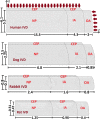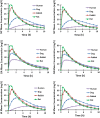Disc size markedly influences concentration profiles of intravenously administered solutes in the intervertebral disc: a computational study on glucosamine as a model solute
- PMID: 24375329
- PMCID: PMC3960428
- DOI: 10.1007/s00586-013-3142-5
Disc size markedly influences concentration profiles of intravenously administered solutes in the intervertebral disc: a computational study on glucosamine as a model solute
Abstract
Purpose: Tests on animals of different species with large differences in intervertebral disc size are commonly used to investigate the therapeutic efficacy of intravenously injected solutes in the disc. We hypothesize that disc size markedly affects outcome.
Methods: Here, using a small non-metabolized molecule, glucosamine (GL) as a model solute, we calculate the influence of disc size on transport of GL into rat, rabbit, dog and human discs for 10 h post intravenous-injection. We used transient finite element models and considered an identical GL supply for all animals.
Results: Huge effects of disc size on GL concentration profiles were found. Post-injection GL concentration in the rat disc reached 70% blood concentration within 15 min but remained below 10% in the human disc nucleus throughout. The GL rapidly penetrated post-injection into smaller discs resulting in homogeneous concentrations. In contrast, GL concentration, albeit at much lower levels, increased with time in the human disc with a small outward flux at the annulus periphery at longer periods.
Conclusions: Changes in the disc size hugely influenced GL concentrations throughout the disc at all regions and times. Increases in administered dose can neither remedy the very low concentration levels in the disc center in larger human disc at early post-injection hours nor alter the substantial differences in concentration profiles estimated among various species. The size effect will only be exacerbated as molecular weight of the solute increases and as the endplate calcifies. Extrapolation of findings from animal to human discs on the efficacy of intravenously administered solutes must proceed with great caution.
Figures








Similar articles
-
Computational pharmacokinetics of solute penetration into human intervertebral discs - effects of endplate permeability, solute molecular weight and disc size.J Biomech. 2012 Aug 31;45(13):2195-202. doi: 10.1016/j.jbiomech.2012.06.033. Epub 2012 Jul 27. J Biomech. 2012. PMID: 22840491
-
Solute transport in intervertebral disc: experiments and finite element modeling.Ann N Y Acad Sci. 2009 Apr;1161:44-61. doi: 10.1111/j.1749-6632.2008.04075.x. Ann N Y Acad Sci. 2009. PMID: 19426305
-
Glucosamine supplementation demonstrates a negative effect on intervertebral disc matrix in an animal model of disc degeneration.Spine (Phila Pa 1976). 2013 May 20;38(12):984-90. doi: 10.1097/BRS.0b013e318286b31e. Spine (Phila Pa 1976). 2013. PMID: 23324939 Free PMC article.
-
Absorption, distribution, metabolism and excretion of glucosamine sulfate. A review.Arzneimittelforschung. 2001 Sep;51(9):699-725. doi: 10.1055/s-0031-1300105. Arzneimittelforschung. 2001. PMID: 11642003 Review.
-
What have we learned from finite element model studies of lumbar intervertebral discs in the past four decades?J Biomech. 2013 Sep 27;46(14):2342-55. doi: 10.1016/j.jbiomech.2013.07.014. Epub 2013 Aug 3. J Biomech. 2013. PMID: 23962527 Review.
Cited by
-
The co-occurrence of spondylodiscitis and periprosthetic joint infections: clinical and microbiological perspectives.Int Orthop. 2025 Jul;49(7):1599-1606. doi: 10.1007/s00264-025-06556-7. Epub 2025 May 14. Int Orthop. 2025. PMID: 40366414
-
MRI quantification of human spine cartilage endplate geometry: Comparison with age, degeneration, level, and disc geometry.J Orthop Res. 2016 Aug;34(8):1410-7. doi: 10.1002/jor.23315. Epub 2016 Jun 19. J Orthop Res. 2016. PMID: 27232974 Free PMC article.
-
Effects of Glucose Deprivation on ATP and Proteoglycan Production of Intervertebral Disc Cells under Hypoxia.Sci Rep. 2020 Jun 1;10(1):8899. doi: 10.1038/s41598-020-65691-w. Sci Rep. 2020. PMID: 32483367 Free PMC article.
-
Intradiscal pharmacokinetics of oral antibiotics to treat Chronic Lower Back Pain.NPJ Antimicrob Resist. 2023 May 10;1(1):1. doi: 10.1038/s44259-023-00002-7. NPJ Antimicrob Resist. 2023. PMID: 39843549 Free PMC article. Review.
-
Prospective Evaluation of Local Sustained Release of Celecoxib in Dogs with Low Back Pain.Pharmaceutics. 2021 Jul 30;13(8):1178. doi: 10.3390/pharmaceutics13081178. Pharmaceutics. 2021. PMID: 34452138 Free PMC article.
References
Publication types
MeSH terms
Substances
LinkOut - more resources
Full Text Sources
Other Literature Sources

